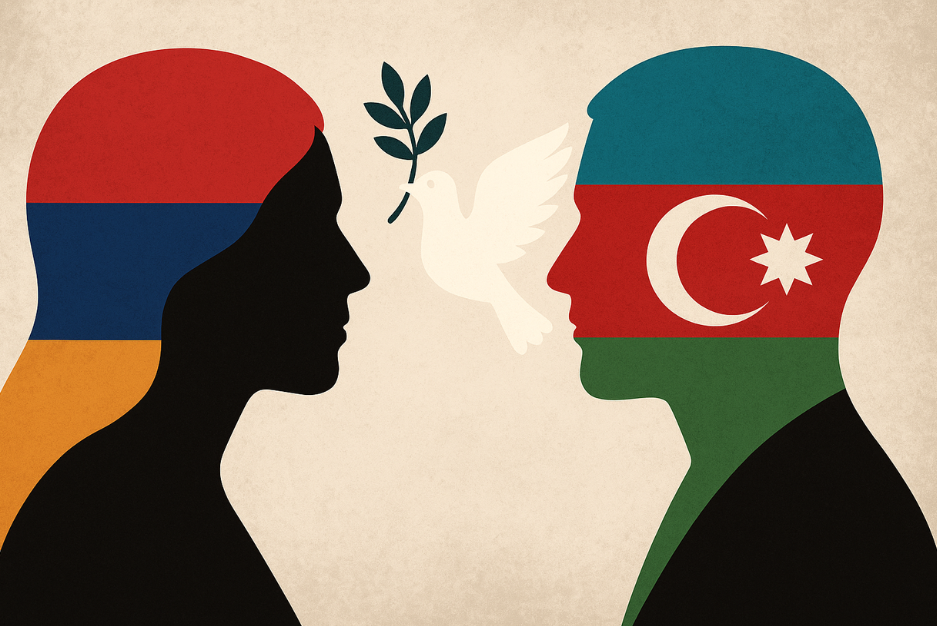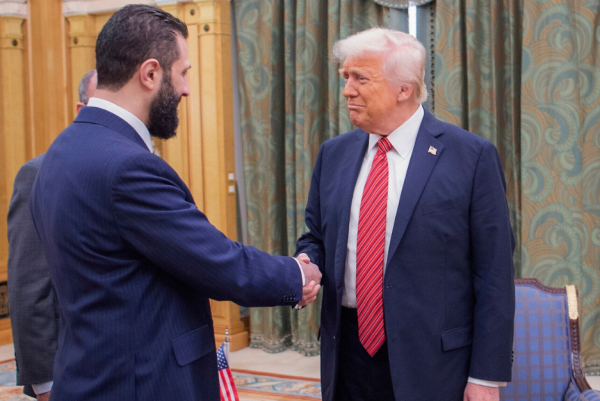Ontological security and the Armenia-Azerbaijan conflict: Post-2020 identity crises and paths to peace

Introduction
The Armenia-Azerbaijan conflict has long been understood as an ethno-territorial one. Yet, through the lens of ontological security, it was also a matter of identity continuity as well as existential reassurance. In international relations and security studies, ontological security refers to the more-than-material desire of actors (states, communities) to sustain a stable identity, a coherent narrative of self, and a sense of continuity amid uncertainty (Mitzen, 2006). Ontological insecurity arises when actors feel their identity or collective narratives are threatened (e.g., by trauma, contestation, or disruptive change) (Giddens, 1991). Both Armenia and Azerbaijan have historically relied on a mutually mirrored ontological framework in which enmity itself provided predictability and a coherent sense of self. For decades, the “other” was central to national self-understandings, which made peace appear less stabilizing than continued rivalry. In such conflicts, ontological insecurity is deeply embedded: each side contests not just territory but histories, memory, belonging, and recognition (Kim & Morrow, 2024). Narratives (who “belongs,” who “is rightful,” whose version of history counts) become existential battlegrounds.
The 2020 war fundamentally disrupted this equilibrium, which triggered divergent ontological frameworks. For Azerbaijan, military victory produced ontological affirmation: a narrative of restoration and pride. For Armenia, defeat generated an ontological shock that dismantled deeply rooted identity scripts tied to the conflict. This asymmetry is destabilizing. Whereas prior decades maintained a fragile yet predictable structure of antagonism, the post-war period is more volatile: Azerbaijan’s triumphalism collides with Armenia’s search for identity amid loss, heightening the risk of renewed hostility. Without addressing these crises of self, traditional peacebuilding mechanisms are likely to falter, as identity anxieties obstruct compromise and deepen mistrust.
The paper examines how ontological insecurity functions as an obstacle to reconciliation in the South Caucasus and highlights potential pathways for mitigation. These include reshaping educational and media narratives, increasing people-to-people engagement, and creating spaces for acknowledgment and healing of past grievances. One recommendation would be the use of artificial intelligence in knowledge production by deploying AI to monitor hate speech, map narrative biases, and support the development of fact-based historical accounts. Together, these measures aim to provide new sources of ontological stability that are not dependent on enmity.
By situating the Armenia-Azerbaijan conflict within the broader scholarship on ontological security, this study contributes to debates in peace and security studies on how identity anxieties perpetuate intractable conflicts. The resolution requires not only political agreements but also the transformation of identity routines. Addressing ontological (in)security directly is essential if the region is to move beyond a precarious post-war order toward sustainable peace.
Pre-2020 and identity formation
In the South Caucasus, the Karabakh conflict became the crucible of post-Soviet national identities. With the collapse of the Soviet Union, neither Armenia nor Azerbaijan possessed a comprehensive history of independent statehood. Instead, both underwent new chapters of antagonism in the 1990s, shaped largely in opposition to each other. For Armenia, the defence of Karabakh symbolized survival against “Turkic and Islamic colonizers,” tying statehood to narratives of victimhood and resistance (Ahmadzada & Gamaghelyan, 2025). For Azerbaijan, the loss of Karabakh was experienced as national humiliation and an injustice magnified by perceptions of external powers siding with Armenians. These interpretations became institutionalized through textbooks, media, and other practices and created a feedback loop of enmity that ensured each society’s self-definition was anchored in opposition.
Although the conflict was “frozen” militarily for decades, ontologically, both sides found a perverse stability. Armenian nationalism centered around the defence of Karabakh as an existential duty, while Azerbaijani nationalism - around the grievance of “lost lands” and created a mirror script: national humiliation, occupation, and the promise of eventual restoration. In both cases, confrontation itself became the relationship that reduced uncertainty about identity. The Other, though threatening, made the Self legible.
Mitzen argues that states may cling to even harmful or costly routines because they provide ontological stability (Mitzen, 2006). This helps explain why, during the 1990s and 2000s, neither side embraced compromise despite devastating economic and human costs. Both Yerevan and Baku feared that altering the familiar pattern by conceding territory or opening new diplomatic frameworks would destabilize the national Self. In Yerevan, abandoning Karabakh would mean unraveling the very narrative of survival and heroism that sustained post-Soviet Armenian statehood. In Baku, accepting the loss of Karabakh would mean permanent humiliation, denying the Azerbaijani Self of dignity and liberation. Thus, the material logic of the security dilemma was strengthened by an ontological one and meant that the status quo was costly but relatively safe.
In the Armenian and Azerbaijani case, Bahar Rumelili’s perspective on how identities are constructed through boundaries and encounters with Others (Rumelili, 2015) shows that these boundaries were drawn in absolute, exclusionary terms. Armenians as heroic victims, Azerbaijanis as aggressors; or Azerbaijanis as righteous victims, Armenians as occupiers backed by foreign powers. Rumelili emphasizes that such boundary-making offers stabilization or ontological lock-in, but it also forecloses the liminal space where identities might be reimagined (Rumelili, 2015). In Rumelili’s interpretation, “liminal space” refers to an in-between zone, a conceptual and experiential space where fixed identities, roles, and boundaries are suspended, allowing for transformation and redefinition (Rumelili, 2015). Peace talks or people-to-people projects that attempted to soften these boundaries often generated anxiety: they opened liminal possibilities of coexistence, but elites and publics alike re-secured themselves by reasserting hardened distinctions.
Seen through this lens, the “frozen conflict” was less a failure to resolve material disputes than a successful routine of identity reproduction. Armenian and Azerbaijani societies found continuity by positioning themselves against each other. In Mitzen’s terms, enmity became a dependency: the relationship endured because it provided ontological security even as it blocked material progress (Mitzen, 2006). In Rumelili’s terms, encounters with the Other were consistently managed through re-securitization, not through liminality as transformation (Rumelili, 2015).
The implication is that before 2020, peace itself was ontologically destabilizing. To many Armenians, relinquishing the Karabakh struggle would dissolve the identity of a people defined by survival and resistance. To many Azerbaijanis, accepting the loss of Karabakh would mean living permanently as a humiliated nation. In both cases, the Other was indispensable for sustaining the Self. Theories of ontological security thus reveal why the conflict persisted for decades despite periodic negotiations: peace threatened identity more than war did.
Post-2020 identity crises
The 2020 Second Karabakh War disrupted the routines that had long anchored identity in both Armenia and Azerbaijan. From the perspective of ontological security, the war’s outcome produced asymmetrical shocks: ontological affirmation for Azerbaijan and ontological dislocation for Armenia.
Azerbaijan: victory as ontological affirmation
For Azerbaijan, the military triumph fulfilled the long-standing narrative of victimhood and restoration. Through Mitzen’s lens, this victory supplied a powerful new routine that stabilized the national Self (Mitzen, 2006). For decades, Azerbaijani identity was anchored in grievance, humiliation, injustice, and the promise of liberation. The war’s outcome transformed grievance into vindication: “lost lands” were restored, and national dignity reaffirmed. This ontological “closure” allowed leaders to recast the Self from a wounded victim to a triumphant restorer of justice.
Yet Mitzen reminds us that states often become dependent on familiar routines of enmity. Azerbaijan’s triumphalism did not dissolve the conflict narrative but extended it: rather than demobilizing the Other, victory entrenched Armenia as a permanent foil (Mitzen, 2006). National rhetoric shifted from “occupied Karabakh” to visions of “Western Azerbaijan”, ensuring that the Other remained central to the Self. In Mitzen’s terms, even as the material status quo changed, the ontological security dilemma persisted: predictability still required an enemy.
Rumelili’s notion of liminality sharpens this paradox. Victory opened a liminal space in which Azerbaijan could have redefined itself not only against Armenia but also as a confident regional actor no longer trapped by grievance (Rumelili, 2015). Instead, political elites largely chose to manage liminality by re-securitizing boundaries: Armenian Otherness was maintained as a symbolic marker of Azerbaijani unity. Rather than reimagining coexistence, liminality was resolved by doubling down on exclusion. Thus, the war stabilized the Azerbaijani Self but locked it into a new form of dependency on triumphalism.
Armenia: defeat as ontological disclocation
For Armenia, the war was a huge ontological shock. The defense of Karabakh had been central to national identity for three decades, a narrative of heroic survival against overwhelming odds. Its loss dismantled this script. From Mitzen’s perspective, defeat shattered the routines that anchored the Armenian Self (Mitzen, 2006). Suddenly, the longstanding performance of resistance no longer applied. Leaders faced the impossible task of sustaining ontological continuity in the absence of the central narrative that had long underpinned legitimacy.
Prime Minister Pashinyan’s post-war discourse illustrates this crisis. In 2019, he declared “Artsakh is Armenia, period” (Armenpress, Aug. 5, 2019). After defeat, he attempted to pivot toward a new routine: reframing identity around “Real Armenia” within internationally recognized borders. “Real Armenia,” in Pashinyan’s usage, seeks to recenter the national imaginary on the existing Republic of Armenia, its internationally accepted territory and institutions, rather than on historical Armenia, which often implies irredentist claims, aspirations toward greater Armenia, or the incorporation of Karabakh as a component of the Armenian polity. However, this redefinition is heavily criticised by some, who argue that it may represent a symbolic capitulation to loss, by excluding claims, it could be seen as abandoning a dimension of Armenian victimhood and resistance narratives.
But Mitzen’s insight is that identity routines cannot be discarded overnight; their loss produces anxiety and instability. Many Armenians, disoriented by the collapse of familiar scripts, turned to revanchist voices promising restoration. In this sense, Armenia exemplifies the vulnerability Mitzen describes: the removal of conflict routines leads not to peace, but to ontological insecurity (Mitzen, 2006).
Rumelili’s perspective clarifies Armenia’s predicament. The post-war moment thrust Armenia into liminality: no longer able to sustain its old heroic categories, yet unable to fully embrace new ones. The Self hovered between victimhood, defeat, and possible redefinition. This liminality carried both dangers and opportunities. On one hand, it created anxiety that fueled polarization and nationalist backlash. On the other hand, it opened imaginative space for re-narrating Armenian identity around survival, reform, and regional integration. The choice between re-securitizing the Other and embracing narrative innovation remains contested in Armenian politics.
Asymmetry and instability
Together, these trajectories create a volatile asymmetry. Azerbaijan enjoys ontological confidence from victory but continues to anchor its Self in antagonism. Armenia experiences ontological fragility, searching for new routines amid loss. In Mitzen’s terms, both remain attached to conflictual routines, one through triumph, the other through grievance. In Rumelili’s terms, both have responded to liminality largely by reinforcing boundaries rather than reimagining coexistence (Mitzen, 2006).
The result is a post-2020 ontological security dilemma: the old equilibrium of mirrored enmity is broken, but neither side has yet constructed alternative routines that make peace feel stabilizing. Without deliberate identity work, Azerbaijan’s triumphalism and Armenia’s crisis risk colliding in renewed hostility.
Ontological insecurity and the peace dilemma
The post-2020 moment in the Armenia–Azerbaijan conflict illustrates the paradox of ontological security: the very conditions that make peace materially feasible simultaneously generate identity anxieties that obstruct reconciliation. Peace, in this context, is not merely a political or military arrangement but an ontological challenge.
Mitzen’s framework explains why states may resist compromise even when it promises material benefits. Conflict provides routines such as enemy images, commemorations, and diplomatic scripts that stabilize the Self (Mitzen, 2006). When these routines are threatened, uncertainty arises. In the South Caucasus, both Armenia and Azerbaijan derived identity continuity from mutual antagonism: the Armenian Self as heroic defender, the Azerbaijani Self as unjustly victimized but resilient. When war altered these scripts in 2020, each society faced ontological dislocation. Azerbaijan’s triumph required a continued role for Armenia as defeated Other, while Armenia’s loss made its old routines unworkable yet offered no settled replacement. Peace negotiations, rather than reassuring, risk exacerbating insecurity by stripping away the predictable roles each side knows how to perform.
Rumelili’s emphasis on liminality sharpens this dilemma. Post-war transitions are liminal spaces: old categories collapse but new ones have not yet been institutionalized. For Armenia, liminality takes the form of being neither victorious nor reconciled, suspended between victimhood and possible redefinition. For Azerbaijan, liminality arises from the shift from grievance to triumph, demanding new narratives to justify continued mobilization against an Other that has already been militarily subdued. Liminality creates the possibility of re-imagining coexistence, but also the risk of anxiety-induced re-securitization.
From an ontological security perspective, peace is threatening for two reasons. First, it removes the enemy relationship that has long stabilized identities. For decades, Armenians and Azerbaijanis knew who they were because they knew who they were not. Peace unsettles this boundary, forcing both sides to confront ambiguity. Second, peace demands narrative innovation. Leaders must persuade societies to accept new roles: Azerbaijan as a confident state without grievance, Armenia as a redefined state without Karabakh. Yet, as Mitzen underscores, narrative change is politically dangerous because audiences fear discontinuity (Mitzen, 2006). Leaders who attempt it, like Pashinyan, face resistance from domestic rivals who promise a return to the familiar conflict script.
The result is what might be termed an ontological security dilemma of peace. Armenia and Azerbaijan cannot feel secure without stable routines, but the routines available to them are conflictual. Attempts to move toward peace trigger anxiety because they disrupt entrenched narratives; attempts to preserve stability through familiar scripts perpetuate antagonism. This creates a self-reinforcing trap: each side experiences ontological insecurity at the very moment peace seems possible.
For Azerbaijan, the danger is triumphalism, where ontological stability depends on continually invoking Armenian Otherness. For Armenia, the risk is paralysis or revanchism, as ontological insecurity makes re-narration politically costly. Together, these dynamics stall negotiations, delegitimize peace proposals, and sustain the possibility of renewed conflict.
Paths to peace: an ontological security approach
If ontological insecurity explains why peace feels threatening in the Armenia-Azerbaijan conflict, then a sustainable reconciliation must address identity anxieties directly rather than assuming that treaties or deterrence alone will suffice. From Mitzen’s perspective, the task is to replace the conflict routines that have long stabilized Self-Other relations with new routines that anchor identity in non-antagonistic ways (Mitzen, 2006). From Rumelili’s perspective, the challenge is to navigate liminality productively, transforming the unsettling ambiguity of post-war transitions into an opening for narrative innovation rather than a trigger for re-securitization (Rumelili, 2015). It means peacebuilding must aim to provide societies with fresh sources of ontological security that are not dependent on enmity.
This process of the rebuilding of ontological security could start with the rewriting of educational and cultural narratives, for instance, school textbooks, public memorials, and media, that in both Armenia and Azerbaijan reproduced enemy images as stabilizing scripts. To move beyond this, curricula should present pluralistic histories that acknowledge suffering on both sides and introduce students to the humanity of the Other. Rumelili has emphasized that peace anxieties can only be managed through the construction of alternative self-narratives at multiple levels; joint history projects, cross-border academic dialogues, and cultural exchanges can serve precisely this purpose. While nationalist elites will resist, external incentives and sustained pressure from civil society can reduce the political costs of narrative innovation and reward “bridge-builders” rather than grievance entrepreneurs.
Equally vital is reforming media and communication. Mitzen reminds us that identity routines are performed daily, and in Azerbaijan and Armenia, these performances occur most visibly in the press and on television (Mitzen, 2006). State propaganda that depicts the Other as existentially threatening may stabilize ontological identity in the short term but ensures perpetual conflict. Shifting these routines requires both structural change, such as guaranteeing space for independent broadcasters and enforcing prohibitions against hate speech, and grassroots interventions, like media literacy programs and collaborative journalism initiatives. By embedding new communication practices into daily life, societies can come to see coexistence itself as predictable and routine, thereby supplying ontological reassurance.
Ontological security also requires the normalization of peace through people-to-people contact. As Rumelili’s work on liminality suggests, identity transformation often occurs through encounters with Others in spaces where boundaries are softened. Cross-border exchanges between students, artists, religious groups, and sports teams can create new social scripts in which the Other is experienced not as an enemy but as a partner in shared activities. These interactions do not eliminate difference, but they resymbolize it, turning it into a manageable dimension of identity rather than a source of existential threat. Over time, such contacts provide the micro-routines through which new identities take shape.
Acknowledgement and historical justice form another cornerstone. Mitzen notes that the routines of truth commissions, memorials, and shared commemorations are not peripheral but central to ending enduring conflicts because they offer new rituals of identity stabilization (Mitzen, 2006). For Armenia and Azerbaijan, this would mean confronting difficult histories of displacement and war crimes and institutionalizing recognition. Joint commemorations or scholarly investigations into past violence could gradually shift the mnemonic landscape from exclusive victimhood to shared acknowledgement. By creating predictable rituals of reflection, such practices can provide ontological continuity while softening antagonism.
One of the core drivers of ontological insecurity is the dominance of singular historical narratives, exclusion of “other” voices, and the persistence of silences and gaps in collective memory (Rumelili, 2015). AI tools (e.g. large language models, generative text/image systems) can assist in generating alternative narratives. It can also help communities to “fill in” gaps, especially voices marginalized in mainstream discourse (minority groups and populations from the conflict-affected regions of both countries). For instance, an AI-assisted project can transcribe and compare interviews from both the Armenian and Azerbaijani sides. It can detect similar and different patterns and consequently produce a narrative that is not purely zero-sum.
AI could help historians with synthesizing large quantities of textual, archival, and interview data. For instance, Optical Character Recognition (OCR) models trained on Armenian and Azerbaijani scripts can digitize handwritten or typewritten archival materials, Automatic speech recognition (ASR) can transcribe oral histories and testimonies in multiple dialects. Machine translation models can make these sources cross-accessible. Once vast quantities of text are digitized, AI-powered semantic analysis allows historians to identify patterns invisible to manual reading. AI could reveal how the term “homeland” (in Armenian, hayrenik, and in Azerbaijani, vətən) shifts in meaning across time or sources. Sentiment and discourse analysis could trace how trauma, victimhood, or heroism are narrated in Armenian and Azerbaijani public memory.
In the Armenia-Azerbaijan context, machine learning algorithms could also monitor social media for hate speech. For example, if AI detects a sudden spike in rhetoric around “erasure,” “genocide,” or “denial,” it could flag this for moderation. AI could also support fact-checking initiatives. Natural language processing could compare and revise competing historical accounts in textbooks, while interactive AI-driven platforms could present young people with multiple perspectives on sensitive events.
Conclusion and policy recommendations
Armenia and Azerbaijan will only escape their ontological security dilemma when enmity ceases to be the main provider of continuity. The task, therefore, is to transform the structures of meaning and construct alternative routines for identities. By embedding new routines in education, media, commemoration, or technology, Armenians and Azerbaijanis can come to experience stability without requiring enmity. According to Rumelili, liminal moments are dangerous but also transformative, while Mitzen shows that routines can be remade to sustain identity differently (Mitzen, 2006). The challenge is to use the instability of the post-war period to anchor new narratives before old antagonistic scripts reassert themselves. Here are a few policy recommendations on how to use the current liminal moment in the Armenia-Azerbaijani conflict:
1. Establishment of a joint curriculum reform commission to rewrite school textbooks. The aim is to include multi-perspective narratives acknowledging suffering on both sides and teaching critical empathy. Comparative education reform experiences (e.g., Germany-Poland) demonstrate that pluralist curricula reduce intergenerational transmission of enemy images (Rumelili, 2015).
2. Encouragement of joint commemorations (for example, September 27) and shared memorials. These rituals can become new routines of ontological security, stable ways to remember without hostility (Mitzen, 2006).
3. Facilitation of long-term dialogue programs for artists, journalists, academics, and youth to meet regularly. Such encounters create “liminal spaces” where new identities can emerge (Rumelili, 2015).
4. Introduction of media codes of ethics and funding collaborative Armenian–Azerbaijani reporting projects. Media literacy campaigns can counter propaganda and normalize coexistence as an everyday topic of discussion (Mitzen, 2006). Grants and training for journalists to co-produce cross-border stories, using AI-based fact-checking tools to reduce propagandistic distortion. These collaborations could normalize balanced narratives in mainstream media (Mitzen, 2006).
5. Creation of bilateral or multilateral research centers, which will focus on conflict transformation and where researchers could co-author studies (Steele, 2008). In addition, funding academic fellowships where Armenian and Azerbaijani scholars jointly use AI-driven analysis to study conflict narratives. These projects could model cooperative knowledge production (Rumelili, 2015).
6. Development of machine-learning models that monitor public discourse and social media in three languages (Armenian, Azerbaijani and Russian) for spikes in inflammatory rhetoric could be useful. This system could provide early alerts to peacebuilding organizations for timely response.
7. Equip NGOs, educators, and youth organizations with AI-based storytelling and visualization tools to lead local peace education campaigns, which can counter extremist narratives.
References
- • Ahmadzada, S. & Gamaghelyan, F. (2025). Rethinking Identity in the Armenian–Azerbaijani Rivalry. Caucasus Edition: Journal of Conflict Transformation
- • Giddens, A. (1991). Modernity and self-identity: Self and society in the late modern age. Stanford University Press
- • Kim, D. J., & Morrow, D. (2024). Ontological security and protracted conflict in frontier societies: towards a trans-local turn in peacebuilding. Peacebuilding. https://doi.org/10.1080/21647259.2024.2370687
- • Mitzen, J. (2006). Ontological security in world politics: State identity and the security dilemma. European Journal of International Relations
- • Rumelili, B. (Ed.). (2015). Conflict Resolution and Ontological Security: Peace Anxieties. Routledge.
- • Steele, B. J. (2008). Ontological security in international relations: Self-identity and the IR state. Routledge.
- • Pashinyan, N. (2019, August 5). Prime Minister Nikol Pashinyan delivers speech in Stepanakert. Armenpress. https://armenpress.am/eng/news/983592.html







